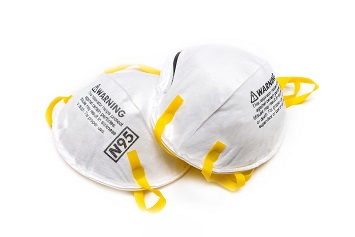The Occupational Safety and Health Administration (OSHA) issued enforcement guidance allowing the decontamination and reuse of N95 respirators during the COVID-19 pandemic on a case-by-case basis. The interim guidance to the agency’s Compliance Safety and Health Officers (CSHOs) allows the reuse, in certain circumstances, of filtering facepiece respirators (FFRs) decontaminated using methods that have shown promise in limited research.
The National Institute for Occupational Safety and Health (NIOSH) and the Centers for Disease Control and Prevention (CDC) provided guidance based on limited research indicating that ultraviolet germicidal irradiation, vaporous hydrogen peroxide, and moist heat have shown the most promise as potential methods of decontaminating FFRs. However, there are no NIOSH-approved methods of decontamination for FFRs. Because decontamination may affect the fit and performance of N95 and other FFRs, decontaminated respirators are not NIOSH-certified.
OSHA instructed its CSHOs to exercise discretion in making decisions about the enforcement of the respiratory protection standard (29 CFR §1910.134).
COVID-19 is a respiratory disease caused by a novel coronavirus, SARS-CoV-2, first identified in Wuhan City, China, in December 2019. U.S. employers have experienced shortages of N95s and other FFRs during the COVID-19 pandemic.
The CDC, NIOSH, and OSHA, along with state agencies, have issued guidance to help healthcare facilities and emergency services maximize the available supply of N95 respirators. Decontamination and reuse of respirators may be one method of extending existing supplies.
OSHA Guidance for Employers
According to OSHA, employers should:
- Make a good-faith effort to provide and ensure workers use the most appropriate respiratory protection available for expected workplace hazards;
- Ensure decontamination is performed according to CDC guidance;
- Ensure employees perform a user seal-check each time they don a respirator and not permit use of a respirator on which the user cannot perform a successful user seal-check;
- Train employees to follow appropriate precautionary measures detailed in the CDC’s guidance before using a decontaminated FFR;
- Train employees using decontaminated respirators to understand that if the structural and functional integrity of any part of the respirator is compromised, it should not be used for respiratory protection—an inability to achieve a successful user seal-check could be an indicator that the integrity of the respirator is compromised;
- Visually inspect, or ensure that workers visually inspect, FFRs to determine if the structural and functional integrity of the respirators has been compromised—components such as the straps, nose bridge, and nose foam material may degrade over time or as a result of decontamination and affect the quality of the respirators’ fit and seal; and
- Train employees on the procedures for properly donning and doffing respirators to prevent self-contamination.
If employers have no manufacturer or third-party guidance or procedures for specific decontamination methods, then workers should avoid using decontaminated FFRs when performing aerosol-generating procedures on patients who are or may be infected with SARS-CoV-2. Aerosol-generating procedures include bronchoscopy, cardiopulmonary resuscitation, intubation and extubation, nebulizer therapy, and sputum induction. Decontamination may degrade FFR performance, and decontaminated respirators may not provide the level of protection needed during such procedures.
OSHA instructed CSHOs to exercise discretion in issuing citations if FFRs are decontaminated and reused in cases when:
- Other feasible measures, such as using partitions, restricted access, the cohorting of patients, other engineering controls, work practices, or administrative controls to reduce the need for respiratory protection, were implemented to protect employees;
- The employer has made a good-faith effort to obtain other alternative FFRs, reusable elastomeric respirators, or powered air-purifying respirators (PAPRs), including NIOSH-certified equipment or previously NIOSH-certified equipment past its manufacturer’s recommended shelf life;
- The employer has monitored its supply of FFRs, prioritized their use according to CDC guidance, and controlled the number of times a respirator is decontaminated before issuing a new one, given supply-level and burn-rate considerations; and
- Surgical masks and eye protection such as face shields and goggles were provided as an interim measure to protect against splashes and large droplets.
OSHA reiterated that surgical masks are not respirators and are not appropriate during aerosol-generating procedures.

